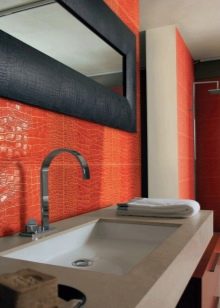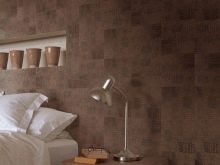Tile "under the skin": pros and cons

Leather-look tiles are a fashionable trend in modern interiors that has recently become popular. Leather tiles are soft and firm to the touch. Wall decoration with such material allows you to bring warmth and comfort to the interior of the room.
The only drawback of wall leather tiles is the high price.



Features and Benefits
Leather tiles are made of leatherette, do not require special care (damp cleaning with any non-aggressive cleaning agent is enough). It has high performance properties, is resistant to abrasion, easy to cut and install, has a wide range of colors.
Leather tiles are expensive, but this only drawback is easy to overcome with the advantages inherent in this material:
- durability (service life is 20 years);
- aesthetic appearance;
- a wide variety of shapes, textures and colors;
- good sound and heat insulation;
- ease of installation.



Application
Leather-like tiles are used for interior decoration. A zebra or crocodile skin finish is ideal for an exotic kitchen (like African). In the kitchen area, a combination of chocolate-colored leather material with white or milk furniture will look beautiful.
Leather coating will be appropriate in a guest room, bedroom or study... By replacing ordinary ceramic tiles with leather, imitating the skin of predators (cheetah, tiger) or alligator, you can turn your living space into a space of refined style and luxurious decoration.
A room decorated in this way will look presentable and fashionable.


Leather tiles blend harmoniously with wood. Using this combination, you can reduce your financial investment in renovations and add an unrivaled sense of style to your room. Leather-like material is used for wall decoration, ceiling space, all kinds of decorative partitions. Thanks to the variety of shapes, textures and shades presented, everyone can find what they need.
Wall and floor coverings differ slightly. Wall tiles have three components: leather, cardboard and foam, which makes them lightweight. The floor tiles have a porcelain stoneware base hidden behind a decorative material, the layer of which is 3 mm.



Price
The average price for leather wall tiles is 2-3 thousand rubles. for 1 m2. An elite collection (made in Italy) costs an order of magnitude more: from 4500 rubles. for 1 m2.
Russian-made flooring will cost 2.5-4 thousand rubles. for 1 m2. Foreign-made tiles (Germany, Poland) will cost from 10,000 rubles. for 1 m2.

Where can I buy?
It is best to purchase leather-like coverage in online stores, since the price there is much lower than in retail outlets. If there is no time to monitor the Internet, you can use the services of specialized construction hypermarkets.
Under no circumstances should you buy leather tiles on the market, as you run the risk of buying a low-quality fake.


Mounting
For laying the tiles, in addition to the leather covering itself, you will need tools and materials:
- primer;
- rag;
- roller;
- level;
- trowel mixture;
- PVA or "liquid" nails;
- tile knife;
- ruler;
- brush;
- pencil.


First, you need to clean the surface on which the tile will be mounted from dust and dirt, and also level it. It is not required to be very zealous, striving to bring the coating to an ideal state.The material can even be laid on a layer of wallpaper if it fits snugly against the wall.
If the walls are made of plywood or chipboard, they must first be primed, and the existing plaster of gypsum must be sanded.
The tile drawing must be marked on the wall in advance using a level, ruler and pencil. Then the material will be glued as smoothly as possible. If you have chosen PVA as the mounting solution, apply it to the back of the material with a brush.


Use a knife to cut the cover. The cut edge will be even if you use a ruler and pen to mark the half of the cover you want to cut and add another 150 mm. Start cutting not from the very edge, but with an indent of 150 mm. You only need to cut a layer of cardboard and foam rubber, a leather layer will be needed to wrap it on the wrong side and glue it there. After completing this work, you need to fill in and grind the seams. When the solution is dry, remove the excess with a damp cloth.
The process of laying leather tiles on a floor is similar to laying regular tiles, but there are some peculiarities. Such material is usually used in rooms that are not characterized by high traffic (working, sleeping area).
During the installation of soft tiles, the use of crosses and grout is not required.


Care
Leather tiles do not require specialized cleaning products. Wet cleaning with soapy water will be sufficient for her. The soft tiles can be vacuum cleaned. Treatment with oils or wax will help to maintain an attractive appearance of the coating for a long time.


The material can be cleaned with 50% alcohol solution and products containing ammonia. The only thing that is not recommended for cleaning leather material is bleach or steam cleaners, as they damage the outer layer of the tile, making it unattractive.
And a little more information about the tiles "under the skin" is waiting for you in the video below.













The comment was sent successfully.